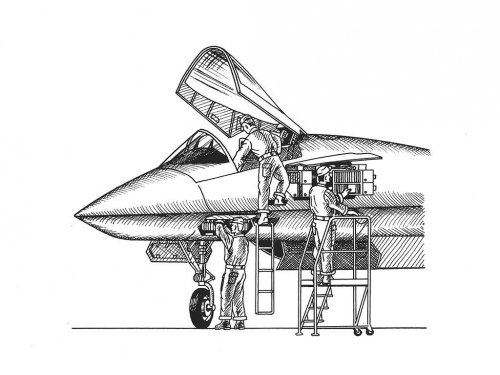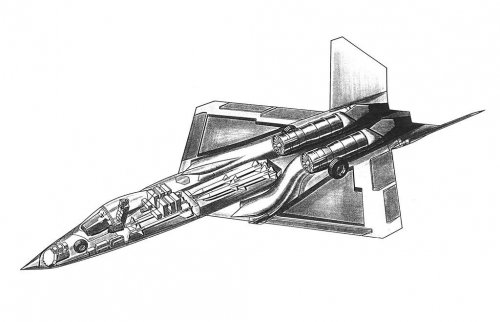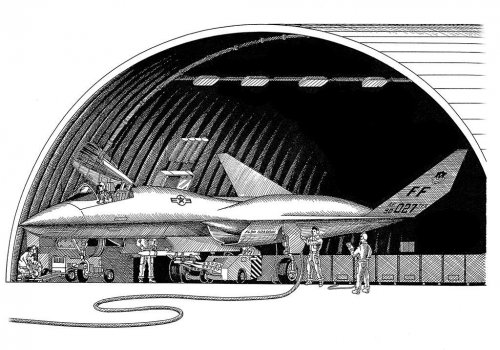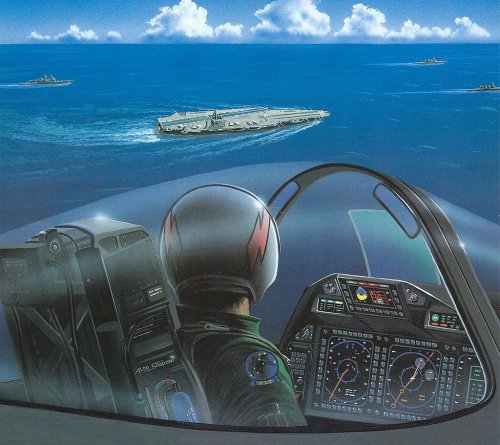- Joined
- 3 June 2011
- Messages
- 18,338
- Reaction score
- 12,240
malipa said:In 1989:The maneuver can be done without thrustvectoring
That's a Cobra. I'm talking about this:
malipa said:In 1989:The maneuver can be done without thrustvectoring
Ogami musashi said:Well by the way, he was referring to the argument that part of LM win was made by "showy" demonstrations, like TVC low speed maneuvers, during the ATF dem/val period.
sferrin said:Ogami musashi said:Well by the way, he was referring to the argument that part of LM win was made by "showy" demonstrations, like TVC low speed maneuvers, during the ATF dem/val period.
No, that's not what I'm referring to at all. I'm referring to the online community thinking more showy equates to more effective. One aircraft can supercruise, is stealthy, superior radar, etc., well it sucks because, "but, but Cobras, backflips, TVC!" Another aircraft has complete awareness of the entire battlefield, is stealthy, can defend itself, and hit targets with pinpoint precision, "it sux 'cuz OMG teh A-10 has the GUUUUNNNNNN!" Maybe the fact that the YF-23 looked so damn cool ('cuz that's important) would have kept it from getting crucified but I doubt it. And while those who know better aren't swayed by the online community, the same cannot be said of politicians. Those holding the purse-strings.
Ogami musashi said:sferrin said:Ogami musashi said:Well by the way, he was referring to the argument that part of LM win was made by "showy" demonstrations, like TVC low speed maneuvers, during the ATF dem/val period.
No, that's not what I'm referring to at all. I'm referring to the online community thinking more showy equates to more effective. One aircraft can supercruise, is stealthy, superior radar, etc., well it sucks because, "but, but Cobras, backflips, TVC!" Another aircraft has complete awareness of the entire battlefield, is stealthy, can defend itself, and hit targets with pinpoint precision, "it sux 'cuz OMG teh A-10 has the GUUUUNNNNNN!" Maybe the fact that the YF-23 looked so damn cool ('cuz that's important) would have kept it from getting crucified but I doubt it. And while those who know better aren't swayed by the online community, the same cannot be said of politicians. Those holding the purse-strings.
I fail to see how this applies to F-23 (obviously, online community wasn't there, and the one who select a plane aren't politician but the military.
Sundog said:DrRansom said:I thought the A-12 had a fundamentally wrong approach to stealth? Quellish said something like the USN had the wrong ideas? This may have been in reference to A-12 low altitude ops and low altitude being bad for low observability?
All of the above. It was just a bad design, as also mentioned by Ben Rich when they asked him to help out with the nozzles. It did look good, though.
marauder2048 said:The USAF's MOA to acquire the A-12 speaks more for the soundness of the design and the validity of its CONOPS than stray remarks
from corporate competitors. Listening to Rich, every competition that Lockheed won was on the merits and every competition they lost was
due to politics.
DrRansom said:I thought the A-12 had a fundamentally wrong approach to stealth? Quellish said something like the USN had the wrong ideas? This may have been in reference to A-12 low altitude ops and low altitude being bad for low observability?
Anyway, A-12 or FB-23 would have saved the USAF a lot of heartache.
Sundog said:marauder2048 said:The USAF's MOA to acquire the A-12 speaks more for the soundness of the design and the validity of its CONOPS than stray remarks
from corporate competitors. Listening to Rich, every competition that Lockheed won was on the merits and every competition they lost was
due to politics.
The A-12 was a political choice by the USAF to get the ATF built, just as the USN agreeing to get a variant of the ATF was so they could get the A-12.
GD had trouble with the heat build up
sublight is back said:DrRansom said:I thought the A-12 had a fundamentally wrong approach to stealth? Quellish said something like the USN had the wrong ideas? This may have been in reference to A-12 low altitude ops and low altitude being bad for low observability?
Anyway, A-12 or FB-23 would have saved the USAF a lot of heartache.
I believe McDonnell Douglas/General Dynamics were waiting for, or under the impression that a significant amount of stealth related data and/or technologies would be provided to them to aid their design efforts.
marauder2048 said:Sundog said:marauder2048 said:The USAF's MOA to acquire the A-12 speaks more for the soundness of the design and the validity of its CONOPS than stray remarks
from corporate competitors. Listening to Rich, every competition that Lockheed won was on the merits and every competition they lost was
due to politics.
The A-12 was a political choice by the USAF to get the ATF built, just as the USN agreeing to get a variant of the ATF was so they could get the A-12.
Much like accepting the F-4 and A-7 was a political choice the Air Force made to get F-X.
Both happened to be superior to anything the Air Force had in the inventory for more than decade.
That's the point you seem unable to grasp. Whatever the shortfalls with the A-12 it would have been
superior to the A-6, the F-14, the F-111 and the "interim" F-15E. And there's still that gap in the US inventory.
GD had trouble with the heat build up
Gasp! An LO design that was thermally challenged? You meet like the B-2, the F-35 and the F-22 which I'm sure you'll
claim Rich engineered. Obviously, Rich is severely overrated as a thermodynamicist.
Or it's just a recurring challenge that these programs have to confront and overcome.
In reality, Rich hadn't engineered anything in 15 years by the time A-12 came around.
Do some research on how quickly your technical skills atrophy as a manager and VP.
Rich ended up as an engineering consultant. And like all consultants there's one overriding motivation: billable hours.
And the inevitable: "if only they had listened to me" when a project doesn't work.
As for Northrop not bidding, they had no engineering resources to spare with B-2, YF-23 and TSSAM.
There was intensive competition for engineering talent in the late 80's which means skyrocketing
wages which is kryptonite to a fixed-price EMD contract.
sferrin said:I wonder how things might have played out if they'd chosen Northrop's ATA design.
Sundog said:As an aero-engineer, I know about the skills and what has atrophied over time, but it isn't difficult to get back in the groove if you know what you're doing. The simple fact, that you refuse to acknowledge, which is actually based on physics, not opinion, is the A-12 was a poor LO design. Could engineering have fixed it? Yes, it's called a new design.
marauder2048 said:And nowhere in those documents which are contemporaneous, official records that were formally admitted into evidence and whose veracity was established by the sworn testimony of those who prepared them do we find any proof for:
1. Thermal management deficiencies
2. Signature deficiencies
3. Survivability deficiencies
marauder2048 said:Fortunately, we don't have consider your background or weigh your opinion because:
marauder2048 said:On the contrary, we have the Navy's chief engineers, DAB, JROC and independent consultants all attesting to the soundness of the design, the CONOPS and the requirements.
The Navy had in fact relaxed the weight requirements which it had acknowledged were too aggressive. Even with GD/MD's weight growth the documents imply it was still lighter than NG's design.
Steven said:I think I've read that the A-12's straight trailing edge gave a substantial RCS spike directly front due to surface diffraction and creeping wave returns.
kilokb said:Roughly 25 years after the rollout and there is still very little informatiom/images about the manufacturing of the YF-23. I have seen quite a few images of both YF-22 prototypes during construction, but I don't think I've ever seen publicly released images of either of the -23 PAVS
:-\
r3mu511 said:Steven said:I think I've read that the A-12's straight trailing edge gave a substantial RCS spike directly front due to surface diffraction and creeping wave returns.
trailing edge returns are actually dominated by edge diffraction contributions in the specular direction if edge alignment is the major concern (ie. concern over straight trailing edges)... the magnitude of the rcs contribution of the edge diffraction can be approximated by the length of the edge squared divided by pi (see equation 7.54 in ch.7 in "Introduction to the Uniform Theory of Diffraction", McNamara/Pistotius)...
with regards to edge location with respect to the incidence direction, trailing edges contribute an edge diffraction return when the electric field is polarized perpendicular to the edge (which can occur for linearly polarized waves where the E field is perpendicular to the trailing edge, or for circularly polarized waves where a component of the E field is perpendicular to the edge, figs. 7.6 and 7.8 in "Radar Cross Section", Knott/Shaeffer/Tuley)...
trailing edge diffraction actually drops considerably when viewed directly head on but rises quickly to the approximate value length^2/pi when the view angle rises slightly (see fig. 14.7 and accompanying discussion in "Radar Cross Section", Knott/Shaeffer/Tuley)...
---
in contrast traveling waves (ie. surface waves if on surfaces exposed to the incident radiation, or creeping waves if on surfaces shadowed from the incident radiation) would reflect back at a surface discontinuity (ie. current discontinuity) regardless of edge alignment but their contributions are typically on the order of the square of the incident wavelength and thus are much smaller compared to the edge diffraction return in the specular direction (ie. direction normal to the edge), traveling wave contributions are thus normally mitigated via surface RAM and/or materials to taper the currents as it nears the surface discontinuity (since it is the discontinuity of the currents at the edge of a surface which causes the reflection of the traveling wave to occur)...
---
given the difference in relative magnitudes of the two contributions (ie. "length^2/pi" for edge diffraction vs. "wavelength^2" for traveling waves), if edge alignment was the major concern (ie. straight edges were used) then it's likely the major concern of contribution was the edge diffraction return (under the assumption that short wavelengths were under consideration, and also under the assumption that the trailing edge was actually a metal structure, and not a dielectric covering a saw-tooth metal edge underneath)...




Steven said:So now it appears that the "fill in" between the nacelles is done so to compensate for the smoothed out nacelles so as to largely maintaining the area ruling of the YF-23. It would also appear that the leaked Koku Fan diagram of the F-23A represents DP232 with the F120 engines, based on the extra serration on the trailing edge of the fuselage.
Why not try to search?FighterJock said:Here is an other F-23 video that I have just found on YouTube, this time featuring test pilots Paul Metz and Jim Sandberg. I hope hat no one has posted this video on this thread before.
The F-23A proposal did indeed had 2 bays and they would have likely seen further refinement to accommodate A2G weapons like the update F-22A undertook around 1994.Ogami musashi said:I don't think any of this is possible since the main weapon bay has a bulkhead that prevent stacking the missile longitudinally like on the F-22. There's room for 6 aim-120C, room for probably more than 2 jdam1K while keeping at least 2 aim-120C, and there's even room for two Jdam 2K but missiles on weapon bay doors was excluded from the proposal as not stealthy (this was one of the reason for going from 1 deep wb to 2 on the emd) and 9 to 12 is probably too much because you need to have sufficient room for the launcher to reach their missiles. That being said if the articulated palet like on the YF-23 was used, using assymetrical weaon carriage like aldo said, you can have pretty interesting mixed weapon arrangement because the palet had the role of imparting a specific movement direction before the launcher extended.
